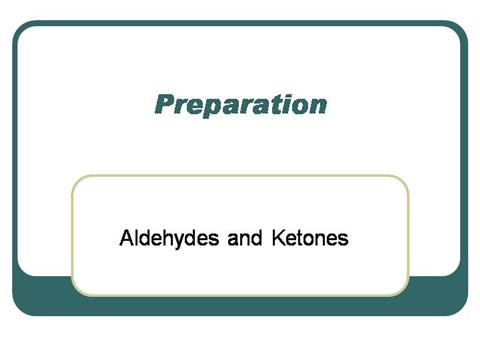Preparation of Aldehydes
Many methods are being used for the preparation of aldehydes depending upon the requirement and type of the compound. Some of the important methods for the preparation of aldehydes are the following.
By Oxidation of Alcohol
By the oxidation of primary alcohols, aldehydes can be obtained.
Dehydrogenation of Alcohols
This method is widely used in the industries. In this method, the passing of primary alcohol over the metal catalyst causes the production of an aldehyde. Preferably, this method is used for the conversion of alcohols to the aldehydes.
From Hydrocarbons
The ozonolysis of the alkenes followed by the reaction of the ozonolysis products with the water and zinc dust causes the making of aldehyde. Depending upon the structure of hydrocarbon a mixture of the aldehyde and ketone is obtained.
From Acyl Chloride
The process of hydrogenation of the acid chlorides by passing them over the palladium catalyst gives the aldehydes.
From Esters and Nitriles
In the presence of stannous chloride when nitriles are reduced to the corresponding imines gives the aldehydes. This reaction is also known as Stephen’s reaction.
By Oxidation of Methylbenzene
By the use of strong oxidizing agents, toluene can be oxidized to the benzoic acid. It is possible to stop this oxidation at the aldehyde stage by the use of reagents suitable for converting the methyl group to the intermediate which cannot be further oxidized.

Preparation of Ketones
From Acyl Chlorides
Ketones are produced by the reaction of the Grignard reagent with the metal halide. For example, the reaction of calcium chloride with the Grignard reagent produces the dialkyl cadmium. This dialkyl cadmium is further reacted with the acyl chlorides causing the formation of ketones.
From Nitriles
When nitriles are treated with the Grignard reagent, then upon their further hydrolysis ketones are yielded.
From Benzenes or Substituted Benzenes
In the presence of Lewis acid such as aluminum chloride the electrophilic aromatic substitution of the benzene ring results in the ketone formation. Popularly this reaction is known as the Friedel Craft’s acylation reaction.
By the Dehydrogenation of the Alcohols
By the dehydrogenation of alcohols, two molecules of alcohols are removed from the molecule of alcohol by the oxidation. In this oxidation process, both carbon-oxygen and hydrogen-oxygen bonds are broken to make the C=O bonds. In the presence of strong oxidizing agents, secondary alcohols undergo dehydrogenation and produce the ketones. For example, the passing of the vapors of secondary alcohol over the heated copper at the temperature of 573K yields the ketones.